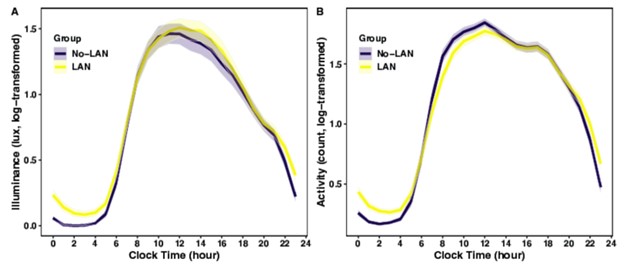Imagine you’re on a swing on a playground with a friend standing behind you.
This friend is not a jerk, so they’re going to push you when a normal person would push you on a swing—right when you’re at the end of your backwards motion and ready to start moving forward again. They, like a normal person, are going to stay out of your way the rest of the time.
If they push you a little bit late or a little bit early, no big deal. If they push you way early, or way late—like, for instance, when you’re still very much in the middle of swinging backwards— that’s a different story. Imagine having your blissful, carefree swing interrupted by smacking into someone standing right in your path. Imagine them actively pushing you back in the direction you came from, right when you least want to be pushed that way.
That person is light exposure. The case where they give you a boost, speed you up, get you to a bigger swing: that’s light exposure during the day. The case where they slow you down, get in your way, reduce the size of your swing: that’s light at night.
And okay, okay: it’s never that simple. “Day” and “night” mean different things based on your body clock’s current time. Light exposure somewhat slowing down your body’s clock is part of a normal day. The same light can affect different people in different ways.
That said, I love this analogy because it captures something I think about a lot in the context of circadian rhythms. The secret of a good swing is having a clear difference between your forward and backwards motion. Shoves are good in the forward direction, and not-so-good in the other direction. Similarly, more and more it seems to me that the secret to healthy circadian rhythms is having a clear difference between the active and inactive parts of your day. When your body wants light, get lots and lots of light. When it’s time for dark, get the darkest dark you can.
I’m thinking about this today because I just read “Light at night in older age is associated with obesity, diabetes, and hypertension” by Kim et al. in the journal SLEEP. Using a dataset of 552 community-dwelling adults aged 63-84, they looked at how exposure to light at night is associated with cardiovascular disease risk factors. They found significant associations between light at night and obesity, diabetes, and hypertension, but no such associations between average light over the course of the 24-hour day and those same risk factors.
In other words, the fact that it’s at night matters. When you get light at night, you muddle the difference between night and day. You lose that good swing.

This paper isn’t the only paper to look at light at night—many others exist—and I don’t want to get in trouble for confusing correlation and causation (the above are correlations only). That said, there are plenty of possible mechanisms by which light could increase your risk of cardiovascular disease.
One is by throwing off your internal clock, so your metabolic machinery is not firing on all cylinders, or is rising and falling in a way that’s mistimed relative to when you’re eating.
Another is by suppressing production of melatonin, which your body produces naturally once a day, but won’t produce if it thinks it’s still light outside. Melatonin has a number of properties that are important for circulatory and metabolic health, so it makes sense that having less of it around may not be the greatest thing for you.
But at the highest level, I find real value in thinking about that swing analogy. There are some things in our body that are meant to be dynamic and strongly rhythmic: breathing, walking, heart rate. Our 24-hour rhythms are no different. Get that good swing by getting lots of light during the day. Keep that good swing by turning them all off at night.
Thanks to the authors of Kim et al. for their great work! We really enjoyed the read.



